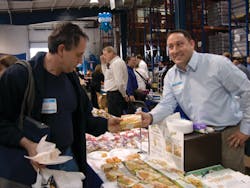B2B trade shows: an underused sales tool for vend/OCS firms
The single most important activity in any vending or OCS company is, or should be, gaining new accounts. Unless you replace the inevitable lost accounts with new ones and compensate for declining same store sales, your business will soon be in serious financial trouble.
In this industry, the selling process has painfully long selling cycles.
Selling new business is often a waiting game; the key is what you do while you’re waiting. In-person sales calls are very expensive, but face-to-face time with new prospects is the only way to sell new accounts. Other marketing activities are helpful, but face-to-face selling is always needed to sign a new customer.
In the traditional sequence of selling new accounts, there are several steps: 1) the initial contact 2) interest in talking 3) interest in the service 4) presenting the proposal 5) signing the contract. The time to complete this process is rarely under 60 days and often stretches out to six months to a year.
What if you could skip steps 1 and 2 and go directly to step 3? It’s worth thinking about when you consider that the average business-to-business field sales call costs between $300 and $400. Maybe it’s time to think about adding an activity that would allow you to be in front of a prospect without having to engage in a hit-and-miss cold call.
Business shows as sales tools
One often overlooked sales activity in vending and coffee service is exhibiting at business trade shows. Business trade shows are usually organized to represent certain industries, most of which include potential vending and coffee service customers.
I am an advocate of exhibiting at business trade shows as a way to get in front of prospective customers. Aside from cold calling, which is expensive, only trade shows can offer you a one-on-one meeting with a potential client.
Usually, attendees at business trade shows are decision makers, or influencers, who come to the show with business challenges to solve and are looking for something newer, better, faster and less costly.
The national vending and foodservice operators participate in business trade shows, oftentimes on a regular basis. And while the nationals have more resources than smaller companies that allow them to exhibit at these events, there is no reason that independents can’t reap the same benefits from business trade shows.
In my years managing vending and foodservice, I found business trade shows to be a helpful sales tool. As a consultant to vending and foodservice companies today, I am surprised that more of them do not participate in these shows.
A trade show can help you accomplish many things all at once. Many independent vending, foodservice and OCS providers are not well known in the markets they serve. In addition to the chance to launch products or services, at a trade show you have an unequaled opportunity to quickly raise the visibility of your company among groups of prospective customers.
Find strategic partners
You can also seek out partners and strategic alliances with other businesses at the show who market different services to the same buyers that you do: i.e., custodial services, grounds and maintenance contractors, copier sales and service suppliers. Perhaps you could share an exhibit booth with one or more outsourced services providers. Some these shared marketing arrangements have been very successful.
As an exhibitor at one particular trade show, I got to know a fellow exhibitor who was an executive with a janitorial services company. We soon learned that while our core businesses were different, our selling process was very similar. We eventually exchanged client lists and invited each other to our various client entertainment events; sporting events and golf tournaments. We actually did gain new business from this alliance.
There are costs involved in exhibiting at a show. And if the wrong type of show is chosen, it will be a waste of time and money. If the booth is not properly presented, with the right materials and the right personnel, it will also be a waste of time and money.
What trade shows make sense?
If you are considering exhibiting at a trade show as a part of your overall marketing strategy, the first question is: which trade shows are attended by prospects, buyers, and influencers that will be interested in your services?
The channels you sell to are: heath care, business and industry, education, government (law enforcement, public transportation, utilities, general administration), hotels/hospitality, recreation, and retailers. There are trade shows, both national and regional, for all of these audiences.
The people attending these business trade shows include the influencers and buyers of food services, OCS and vending services. They typically have the following job functions within the above channels: facilities, procurement, contract administration, property management, human resources, and auxiliary services.
All of the descriptors shown above must be considered in determining which trade show is right for you.
What does it cost to exhibit?
Exhibiting at a trade show takes money, time, effort, creativity, and work. Typically, a 65-square-foot booth costs $17 per square foot or approximately $1,105. You will also have costs associated with banners, literature, trinkets for giveaways, and maybe even video displays. Create a realistic budget that includes the cost of people being out of the office for a few days. Small "tabletop" trade shows are less expensive.
The materials in your booth make a difference in making that key first impression to attendees on the trade show floor.
Giveaway items are important so that people can take something away with your name and contact information on it. Pens can be purchased in bulk, with custom printing, for 30 to 50 cents each. Letter openers, lanyards, calendars, and mouse pads can also be used, but will be more expensive.
Having a food machine in your booth is a good display. Attendees can sample products from this machine using free vend coupons, which you hand out to prospects. And of course, free coffee representing your OCS service will be popular.
A number of companies specialize in trade show supplies. Ace Exhibits and Impact Displays in Los Angeles, Calif. offers affordable show supplies, which are portable and reusable. Booth packages are available for as little as $500. Your product suppliers, particularly bottlers, should be able to help you with free customized banners to be positioned in the booth.
How to work the show floor
Some of the same selling and prospecting rules used in cold calling apply in working trade shows.
Like any other business tactic, you’ll get better results if you begin with the end in mind. Are you going to the trade show to meet new prospects? To launch a new product? To take a leadership role in your industry?
As an exhibitor, you only have about 30 seconds to interact with someone walking by, so prepare a quick sentence or two to tell your story. You will need an “elevator speech,” a one- or two-sentence statement you can make in 15 seconds or less that introduces your company and your unique offer.
Here is a sample dialogue:
Potential buyer: “I am not familiar with your company, what is that you do?”
You: “We are Acme Food and Vending and we provide an extensive menu of reasonably priced, fresh, products that your employees want, through state-of-the-art vending machines.”
The pace of a trade show is very fast. The people in attendance want to see a lot in a short period of time. You will only have a few minutes to make an impression before they are distracted or led away.
There should be no idle chit chat with “tire kickers” while new customers wait for your attention. Train your booth staff to qualify attendees quickly. The time and energy you devote to selling to an unqualified potential buyer is wasted. Meanwhile, new and current customers wait for your attention.
Some people who work at trade shows believe that they have to tell everybody their story. You don’t. Not everyone who attends the show is your potential customer, so quickly identify whether the person you’re talking to can actually benefit from what you have to offer. If they can’t, say goodbye as fast as possible.
When qualifying your trade show prospects, if both parties agree that there’s a possibility of doing business, you should set up your next meeting right there in the booth, on the spot.
The show ends and there is a sigh of relief, but this is when the most important work begins. The follow-up after the show is the most critical phase. If you're not willing commitment to a systematic, structured and timely follow-up after the show, don't go to a trade show as an exhibitor. I have known companies who did a great job on the actual event, only to totally drop the ball on the follow-up after the show.
To find an appropriate trade show, check the Website, www.tsnn.com for a list of some bigger shows.
No matter how small your business may be, the benefits of attending a trade show of a targeted industry with attendees who are potential buyers of your services can be very beneficial.
About the Author
Tom Britten is an analyst, intermediary and professional consultant with more than 30 years of industry experience. He functions as a full service resource available to all vending, OCS and food service companies large and small. Contact Britten Management Services, LLC for a free, and no-obligation consultation at 813-469-5437 or via email: [email protected].
Benefits of exhibiting at business shows
- Get in front of new prospects in one setting
- Allow prospects to sample your wares
- Raise your company's visibility
- Find strategic business partners
About the Author

Tom Britten
Tom Britten is president of Britten Management Services, based in Zephyrhills, Fla. He is a full service consultant to the food and vending industry. He can be reached at 813-469-5437; email: [email protected].
